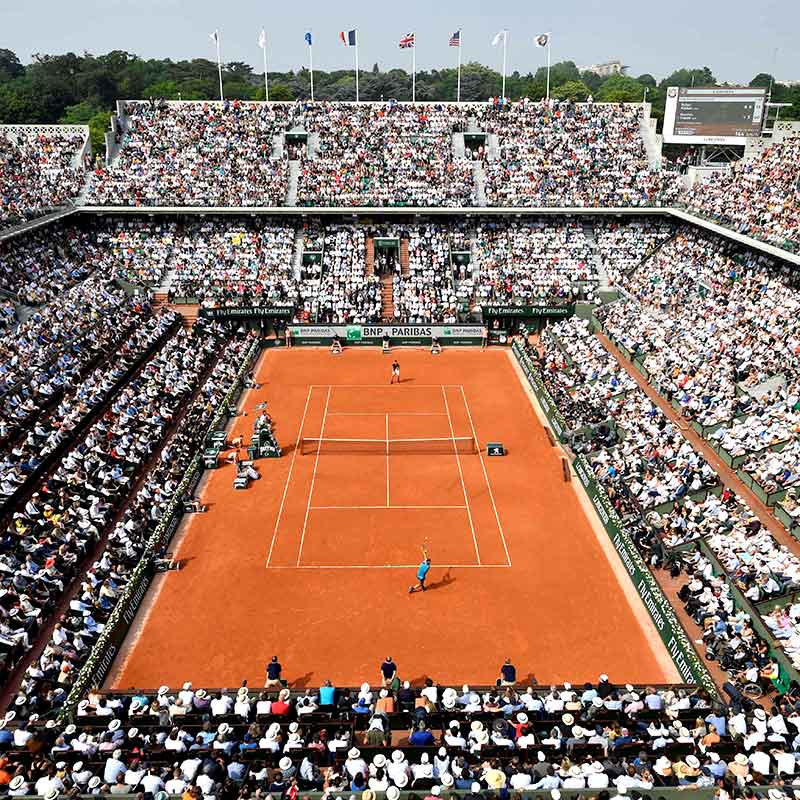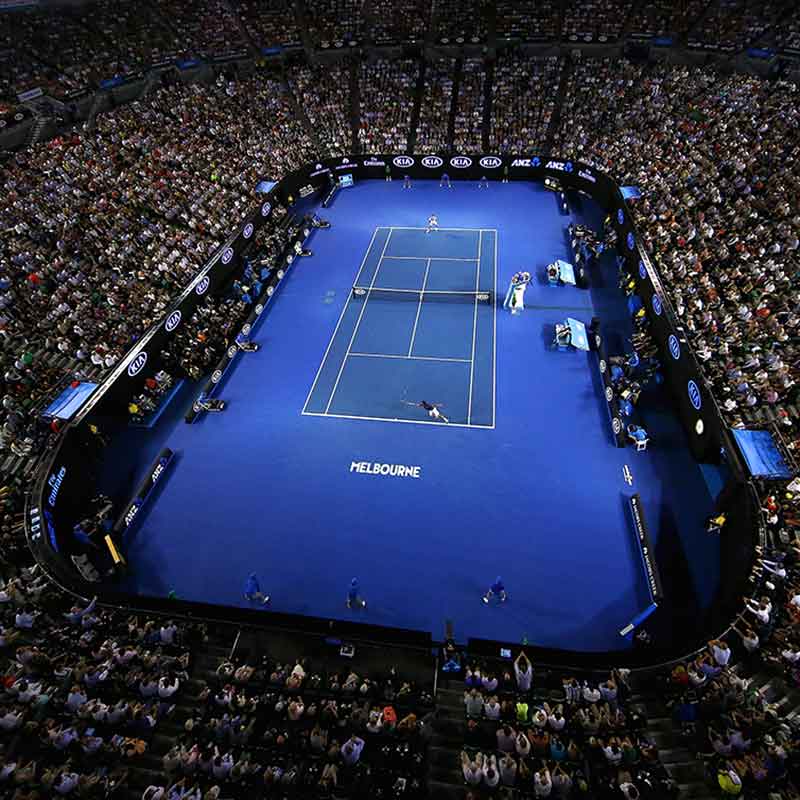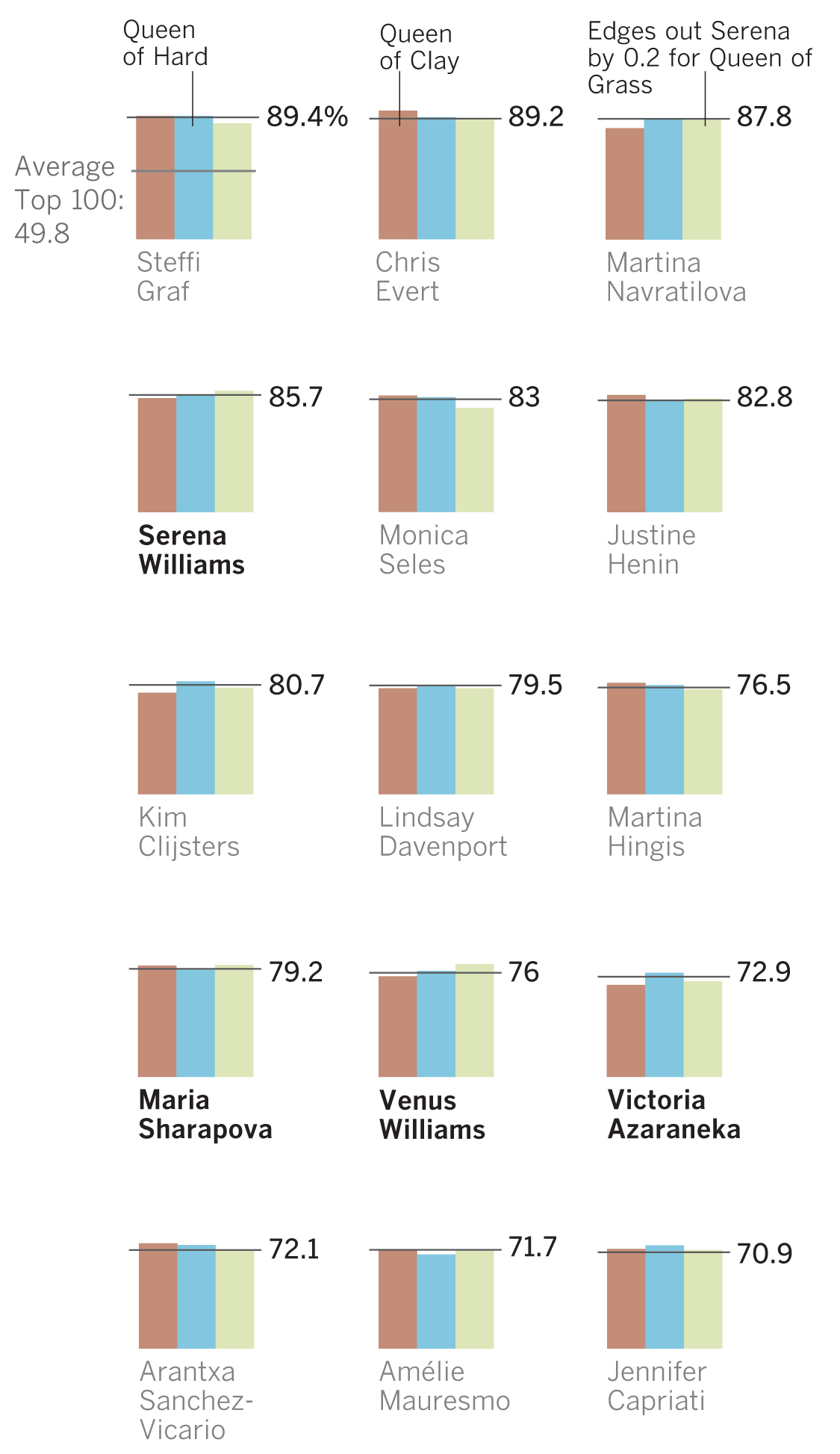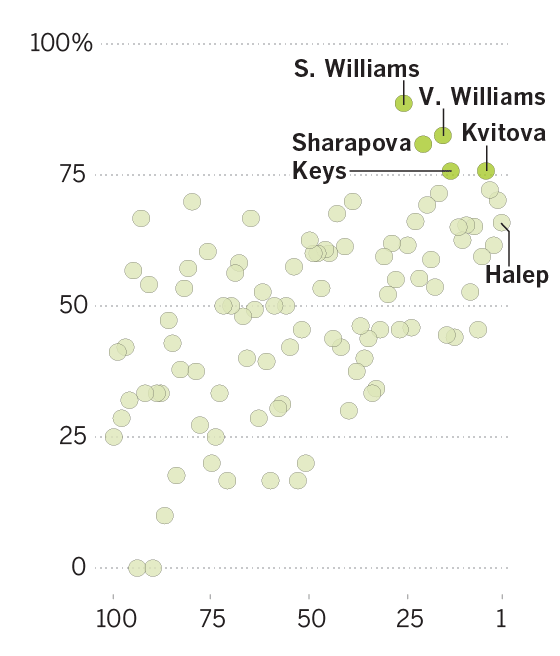Rafael Nadal is the undisputed king of clay.
Chris Evert is its queen.
Roger Federer dominates most on grass, while Novak Djokovic is best on hard courts.
What does it mean to rule each surface?
The definitive guide to the kings and queens of the courts
Perhaps no other major sport is more defined by its playing surface than tennis:
There's the meticulously-manicured grass lawns of Wimbeldon – the oldest of the Grand Slam tournaments. The French Open is home to the striking red clay courts of Roland Garros Stadium. And there's the blues of the Australian and U.S. Open hard courts – the latter now in its final tournament week.




The International Tennis Federation (ITF) recognizes 10 different surfaces. The three main ones are clay, hard and grass and they are considered to have a slow, medium and fast court pace.
Tournaments in a given year by surface

The differences aren’t just for looks.
The surfaces can also dictate how the game – and player – must adapt to each court.

Clay is considered the slowest out of the three due to its composition. When 11-time French Open winner Nadal steps onto the court, he is walking on multiple layers of crushed various gravel and rocks.
The bottom layer is composed of large stones that act as a porous base.
The next layer consists of roughly a foot of crushed gravel.
Next is about 2.5 inches of clinker, which is residue that results from burned rocks.
Near the top is crushed white limestone.
A thin coat of red brick dust is then topped off. The top layer of brick dust aids in adding more friction as it attaches to the ball, which translates to longer rallies.
A tennis ball sailing towards the court at 67 miles per hour at an angle of 16 degrees with no spin will generally fall towards the ground and kick up at an angle of at least 20 degrees, according to court pace testing done by the ITF.
A player like Nadal, who hits much faster and with more topspin, would exaggerate the higher bounce off the court even more.
As a result, clay favors aggressive baseliners who can generate a lot of spin as well as short angled shots near the net. The slower pace can mean longer rallies, and more running and sliding towards balls – a signature trait of playing on clay.
These are the exact attributes Nadal, the most dominant player on clay, possesses and is why he is so dominant on this surface.
On the opposite end of the pace spectrum are the speedy grass courts.
If you peeled back the layers of a court in Wimbledon, at the bottom would be roughly 7 inches of stone and angular construction aggregate over a network of drain pipes.
Then 2 inches of binding layer that includes washed pea gravel are laid.
10 inches of topsoil composed of clay, silt and sand are filled.
A precise 8 mm (0.3 inches) of lawn are rolled out on top. Only 100% perrenial rye grass is used at Wimbledon – a breed often used in various sports due to its durability and resilience.
Grass is perceived to be faster due to the way balls tend to skid or slip on contact, creating a lower exit angle.
Lower balls mean fast-flying balls are that much harder to get to for players and result in shorter points.
Powerful serves, slices and speed are rewarded on this slicker court. Federer and Serena Williams are current players best known to dominate on this surface.
Hard courts like those at the Australian and U.S. Open are the most common type of court in both recreational and pro scenes. Court pace can generally range from medium-slow to medium-fast paces between clay and grass depending on how it's made.
Compact foundation is the base.
Around 2.5 inches of asphalt are then filled in.
If specified, a cushion system.
An acrylic top coat is then applied. The amount of sand used and number of coat layers can either make the surface play slower or faster.
If the same ball previously on clay and grass bounced on a hard court, it would bounce between the two trajectories. It also produces the most consistent ball behavior since it is a consistently hard and flat surface.
Hard courts favor play styles similar to grass. Djokovic, as well as Federer and Williams, currently dominate this surface.
The effects the surfaces have on the game are even more striking when looking at important elements of the game.
Average rally length falls off on grass for both men and women since they are harder to get to.
Rally length and distance chasing down balls, in comparison, are highest on clay for the men's tour. The trend is reversed on the women's side, though with small margins.
Aces for men and women are more common on the faster surfaces
The GOATs, greats and No. 1s 👑
While the best players today play well on all surfaces, not all are created equal. Nadal has a career clay court dominance of 92% – the highest of any current and former top player. He's also won more clay titles than any other player.
While Federer has proven to be an all-time great with 20 Grand Slam titles – the most by anyone – he has the highest win percentage on grass at 87%. Novak Djokovic has a slight edge over Federer on hard courts statistically but Federer has won more titles overall on hard courts.
Most dominant men of all time

While the frequency of who is the queen of each surface may undeservedly be discussed less frequently, there are clear winners. Chris Evert racked up a win rate of a whopping 94% on clay during her career – higher than Nadal's. The only rival to come close to that in the WTA number is Steffi Graf at 90%.
Martina Navratilova barely edges out Serena Williams for the Queen of Grass title – though Serena could take the crown by the time she retires.
Most dominant women of all time

Current top 100 men
Djokovic, Federer and Nadal remain consistently the top on all surfaces among the current top 100 players on the ATP, showing even though they have certain strengths, they also excel on all courts.
Clay dominance

Hard dominance

Grass dominance

Current top 100 women
The most consistently dominant players in the WTA, compared to the men, are currently not in the top 10. Serena, back from pregnancy and attempting to break the all-time record of most grand slam titles in history, possesses the highest overall dominance among the top 100. Other players like Venus Williams and Maria Sharapova wield more consistently dominant games on all surfaces compared to current No. 1 Simona Halep.
Clay dominance

Hard dominance

Grass dominance

About the data
ATP and WTA player stat data is current as of Aug. 27, 2018.
Court composition information was obtained from the International Tennis Federation, Roland Garros, Wimbledon and the manufacturer for DecoTurf and Plexipave.
Ball and court surface testing and behavioral data was provided by Jamie Capel-Davies, head of ITF’s Science & Technical division.
Point by point Grand Slam data from 2015 to 2018 was used for the rally length, court distance and ace data visual where available via Jeff Sackmann’s Tennis Abstract. The Australian Open and U.S. Open were combined for simplicity.
Lorena Iniguez, Swetha Kannan, Chris Keller and Ellis Simani contributed to this project.